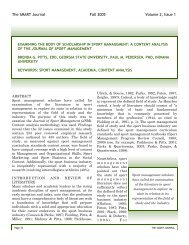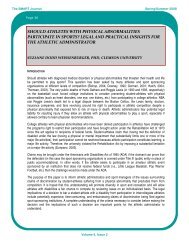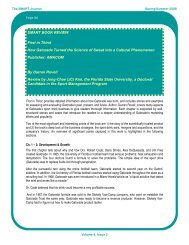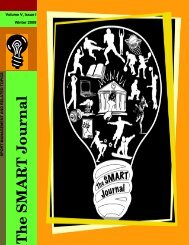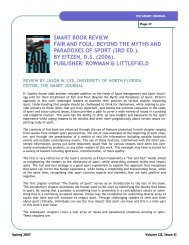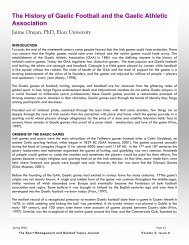Spring/Summer 2008 Volume 4, Issue 2 - The SMART Journal
Spring/Summer 2008 Volume 4, Issue 2 - The SMART Journal
Spring/Summer 2008 Volume 4, Issue 2 - The SMART Journal
You also want an ePaper? Increase the reach of your titles
YUMPU automatically turns print PDFs into web optimized ePapers that Google loves.
<strong>The</strong> <strong>SMART</strong> <strong>Journal</strong> <strong>Spring</strong>/<strong>Summer</strong> <strong>2008</strong><br />
Page 75<br />
This semi-structured interview lasted just over one hundred minutes. <strong>The</strong> interview length allowed the<br />
participant ample time to answer questions regarding the various aspects of a student-athlete’s life. His<br />
answers were immediately transcribed and field notes were included throughout the course of the transcription<br />
process.<br />
ANALYSIS<br />
Merriam (1998) stated that “the right way to analyze data in a qualitative study is to do it simultaneously with<br />
data collection” (p. 163). <strong>The</strong> observations that were recorded during the transcription process represent this.<br />
<strong>The</strong>se field notes represented our first effort to make sense of the statements that were made by the<br />
participant.<br />
<strong>The</strong> data were examined using two methods of analysis. First, we used a narrative approach (Merriam, 1998).<br />
<strong>The</strong> interview transcript was essentially a story of this student-athlete’s life over the course of his four years as<br />
a player (his first year as a red-shirt freshman was not included in the analysis because he was not playing or<br />
traveling with the team). It was critical to tell that story and find out what the story meant. However, to gain a<br />
better understanding of exactly what the story meant, we thought it was best to attempt to pull out several<br />
themes or categories that emerged from the story. <strong>The</strong>refore, we also used a thematic approach to analyze this<br />
data (Merriam). <strong>The</strong>se themes gave a better sense of exactly how he felt about his experience. What were the<br />
dominant themes of his time as a student-athlete? Did he identify more with the “student” side of the term<br />
“student-athlete” or did he become engulfed in his role as an athlete? Is the program about winning and<br />
success or about participation and creating a positive experience? As such, it was critical to identify exactly<br />
which themes emerged from the participant’s experience.<br />
<strong>The</strong> data was coded using open and axial coding (Strauss & Corbin, 1998). In the first step (open coding), data<br />
are “broken down into discrete parts, closely examined, and compared for similarities and differences” (Strauss<br />
& Corbin). <strong>The</strong>se individual parts were then grouped into categories. In the second step (axial coding), these<br />
categories were then compared and contrasted to try to gain a deeper understanding of the phenomena<br />
(Strauss & Corbin). By first deconstructing our data, we were able to then rebuild the information into our<br />
identified themes or categories.<br />
INTERNAL VALIDITY<br />
Internal validity addresses the issue of whether or not the findings in a research study match the reality of the<br />
situation (Merriam, 1998). Merriam poses the question: “Are investigators observing or measuring what they<br />
think they are measuring” (p. 201)? <strong>The</strong>re are two primary ways that this study with address internal validity.<br />
First, we gave the participant every opportunity to speak to any different facet of his intercollegiate athletic<br />
experience. Further, the questions were framed so that he addressed many of the pertinent aspects of a<br />
student-athlete’s life, both academically and athletically. <strong>The</strong> questions raised in this study were unique in that<br />
they do not address many ambiguous terms or events. <strong>The</strong>re should be little question about what the<br />
participant’s responses address.<br />
<strong>The</strong> second method of addressing internal validity was through peer examination. Seeking the feedback of<br />
peers is a useful way to ensure the internal validity of a study. <strong>The</strong> data, interpretations, and findings were<br />
shared between the authors in order to enhance the validity.<br />
EXTERNAL VALIDITY<br />
According to Merriam (1998), external validity is “the extent to which the findings of one study can be applied to<br />
other situations” (p. 207). This concept is also referred to as generalizability or transferability. External validity<br />
<strong>Volume</strong> 4, <strong>Issue</strong> 2



